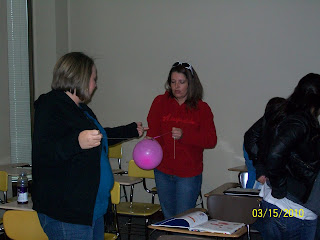Friday, January 13, 2012
Sunday, April 25, 2010
Real Life Science Project



Some liquids may be harmful to plants; therefore, this study should help enlighten us on whether or not vinegar and Sunny-D will harm bean seeds when compared to only using water.
Will vinegar and Sunny-D have detrimental effects on bean seed growth?
Hypothesis:
I believe that vinegar and Sunny-D will prevent seed growth, unlike water.
The materials required:

1.) 3 pots or paper cups
2.) Potting soil
3.) bean seeds (at least 3)
4.) Bottle of vinegar
5.) Bottle of Sunny-D
6.) Water
7.) Measuring spoons
Click here for step-by-step directions (Method) ~~~~~~~~~~~~~~~~~~~~~~~~~~~~~~~~~~~~~~~~~
I planted 2 different types of bean seeds one in each of the 3 pots on April 5; each pot received 2 tablespoons of liquid a day. As of April 25, none of the bean seeds in any of the pots had come through the soil so I decided to dig them up to see what had happened. The pictures above show my results; each picture shows what the beans looked like before & after the experiment.
Water:
One of the beans in the "water pot" had sprouted & the second bean had cracked on the side & looked as though it was about to sprout.
Sunny-D:
One of the beans in the "Sunny-D pot" had swelled & turned black around the edges; it looked like it was trying to rot. The second bean had changed colors & swelled a little too. The pot always looked wet even when it hadn't been watered since the day before & the soil started to smell horrible!
Vinegar:
Both of the beans in the "vinegar pot" were wrinkly and somewhat soggy, unlike the others.
Conclusion:
Water promoted more growth than vinegar or Sunny-D. In fact, vinegar and Sunny-D seemed to have harmful effects on the beans. I believe that the Sunny-D was harmful to the beans because it contains citric acid, malic acid, and ascorbic acid. I also think that vinegar harmed the beans because it's acidic too.
Which soil is the richest? By:Sarah Young
References:
Mad Science
Tuesday, April 20, 2010
Mrs. Spoone's Classroom Communication
In Science Class:
Homework:
Study:
Important Dates:
Chapter 18 test-Thursday, May 6
Museum field trip- Friday, May 15
Science portfolio deadline- Tuesday, May 17
Report cards- Thursday, May 27
Special Note:
I am very pleased with everything we've accomplished this year! The entire class did a great job on their science projects and I know that all of your portfolios will be fantastic. All of your hard work makes me very proud to be your science teacher!
Monday, April 5, 2010
Sunday, March 28, 2010
Get A Jet Going~Page 110
-Balloon
-Sticky tape
-Balloon pump
-Drinking straw



A jet engine sucks in air and heats it with burning fuel. Next, it sends the hot air blasting out from the engine which makes the aircraft move forward at high speeds. This experiment applies a similar concept to a balloon powered by a jet of air which allows us to see how the process works.
Vocabulary Terms:
Potential energy:
Is the same as stored energy. The "stored" energy is held within the gravitational field. When someone lifts a heavy object he/she exerts energy which will later become kinetic energy when the object is dropped.
Kinetic energy:
Is the energy of motion. It is ability to do work. The faster an object moves the more kinetic energy will be produced. The larger the speed & mass of an object, the more kinetic energy it will have. Click here to view a Mini Lesson.
Tennessee Content Standards (5th grade):
Grade Level Expectation 0507.10.1:
Design an experiment to illustrate the difference between potential & kinetic energy.
Grade Level Expectation 0507.11.1:
Design an investigation, collect data and draw conclusions about the relationship among mass, force, and distance traveled. Click here for more content standards
Getting the experiment ready.....
->
Fun fact about the half human, half jet:
Swiss adventurer Yves Rossy a.k.a "Jet Man" was the first to fly across the English Channel using a jet propelled wing that he wears attached to his back! Click below to watch him fly!
National Geographic-Flight of the Jet Man
JET MAN
World Record Attempt
Extended Resources....
Friction "The Motion" of Our Lives-By: Sarah Young
It's electric!-By:Carla Shoemaker
Sunday, February 21, 2010
Experiment #2~See Some Sound (Page 75)
 Materials Needed:
Materials Needed:1. Rubber band
2. Plastic bowl
3. Big saucepan
4. Piece of heavy plastic
5. Uncooked rice
7. Scissors
8. Large spoon
9. Tape
Click here for step-by-step directions
Tennessee Content Standards (3rd grade):
Videos of my results...
->
Report & Observations:
I found that the harder you hit the saucepan the more the rice bounces. The sound waves travel through the air & hit the plastic which makes it vibrate & bounce the rice. I alo tried taking the experiment a step farther by using 2 different sized saucepans (large & small). I concluded that the large saucepan works the best with this experiment because the soundwaves from the smaller saucepan barely made the rice bounce.
Visit the links below for some extra fun!
Monday, February 15, 2010
Seasonal and Lunar Changes
The tilt of the planets rotational axis causes us to have seasons; therefore, the large difference in the amount of the sun's rays reaching the ground in the different hemispheres is what causes the seasons
What causes the phases of the moon?
The moon's phases are mainly caused by 2 things:
1.) The moon's position as it circles Earth
2.) The sun's light it reflects to Earth
Half of the moon is always illuminated, it just isn't always the half that we can view from Earth.
Friday, February 12, 2010
Fight a Fire~Page 33
 The materials required:
The materials required:Vocabulary terms:
Tennessee Content Standards (8th grade):
Click below to check out some fun activities!
Extended resources...













.jpg)